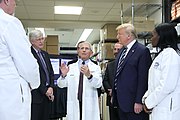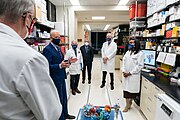Vaccine Research Center
 Logo of the Vaccine Research Center, National Institute of Allergy and Infectious Diseases | |
 Headquarters of Dale and Betty Bumpers Vaccine Research Center in Bethesda, Maryland, United States | |
| Agency overview | |
|---|---|
| Formed | 1997 |
| Headquarters | 39°00′00″N 77°06′26″W / 39.000052°N 77.107353°WCoordinates: 39°00′00″N 77°06′26″W / 39.000052°N 77.107353°W |
| Agency executive |
|
| Parent department | National Institute of Allergy and Infectious Diseases |
| Parent agency | National Institutes of Health |
| Website | www |
The Dale and Betty Bumpers Vaccine Research Center, more commonly known as the Vaccine Research Center (VRC), is an Intramural Division of the National Institute of Allergy and Infectious Diseases, one of the US National Institutes of Health. The mission of the VRC is "to conduct research that facilitates the development of effective vaccines for human disease." The primary focus of research is the development of vaccines for AIDS, but the VRC also is working to develop vaccines for Ebola and the Marburg virus, and therapeutic antibodies against SARS-CoV2 (the virus responsible for COVID-19).[1]
History[]

The VRC is named after the former Governor of Arkansas Dale Bumpers, and his wife Betty Flanagan Bumpers, who are known for their campaigns to promote immunization of children.[2] On May 18, 1997, President Clinton said he wanted the United States to develop an AIDS vaccine within the following ten years.[3] The center was opened under the Presidency of Bill Clinton, himself a former Arkansas Governor.[2] President Clinton dedicated the center on June 9, 1999.[3]
In 1999, Gary Nabel was named the first director of the center by Secretary of Health and Human Services Donna E. Shalala.[4] Dr. Nabel served as director until 2012.[5]
The current director of the VRC is John R. Mascola, M.D., who previously served as deputy director.[6] The deputy directors are Richard A. Koup, M.D.; Barney S. Graham, M.D., Ph.D.; and Julie Ledgerwood, D.O.
Projects[]
HIV[]
In July 2010, a collaboration between the National Institute of Allergy and Infectious Diseases and officials at the Vaccine Research Center found that two human HIV antibodies, named and , could potentially be used against a wide range of types and mutations of HIV in the design of a preventive HIV vaccine for human use, as well as in the formation of better antiretroviral therapy drug cocktails. The discovery, a potentially landmark one in the drive to find a vaccine for AIDS should it be validated and further improved.
Ebola[]

In 2016 research efforts led by Dr. Nancy Sullivan at Vaccine Research Center and Dr. J. J. Muyembe-Tamfum from the Institut National de Recherche Biomedicale (INRB) in the Democratic Republic of Congo resulted in the discovery of a monoclonal antibody, mAb114, from a survivor from the 1995 Kikwit outbreak of Ebola virus disease.[7][8] mAb114 is a monoclonal antibody therapy that is being evaluated as a treatment for Ebola virus disease and has shown great success by lowering the mortality rate from 70% to about 34% in the 2018-2020 Kivu Ebola Virus Outbreak. In August 2019, Congolese health authorities, the World Health Organization, and the U.S. National Institutes of Health promoted the use of mAb114, alongside a similar Regeneron-produced treatment, over other treatments yielding higher mortality rates, after ending clinical trials during the outbreak.[9][10]
Organization[]
The Vaccine Research Center has multiple Research Laboratories (currently Viral Pathogenesis, Virology, and Immunology), and Research Sections (Humoral Immunology, Structural Biology, Human Immunology, ImmunoTechnology, Cellular Immunology, and Biodefense Research), and Programs (Translational Research, Vaccine Production, and Clinical Trials).
Image Gallery[]

President George W. Bush visits the Vaccine Research Center

President Barack Obama visits the Vaccine Research Center

President Donald Trump visits the Vaccine Research Center

President Joseph Biden visits the Vaccine Research Center
Notes and references[]
- ^ Philippidis, Alex (March 16, 2020). "To Develop Coronavirus Treatment, Lilly Taps AbCellera Antibody Platform". GEN: Genetic Engineering & Biotechnology News. Retrieved 19 March 2020.
- ^ Jump up to: a b "Vaccine Research Center Mission and History". Retrieved April 9, 2017.
- ^ Jump up to: a b "The Clinton/Gore Administration: A Record of Progress on HIV and AIDS". National Archives. June 1999.
- ^ Dr. Gary Nabel Named Director of NIH Vaccine Research Center, NIH news release, accessed 7 Jan, 2009, dated March 11, 1999
- ^ Cohen, Jon (November 15, 2012). "NIH vaccine chief Gary Nabel trades dream job for big pharma". Science. Retrieved December 4, 2016.
- ^ "John R. Mascola, M.D." Retrieved April 9, 2017.
- ^ Corti D, Misasi J, Mulangu S, Stanley DA, Kanekiyo M, Wollen S, et al. (March 2016). "Protective monotherapy against lethal Ebola virus infection by a potently neutralizing antibody". Science. 351 (6279): 1339–42. Bibcode:2016Sci...351.1339C. doi:10.1126/science.aad5224. PMID 26917593.
- ^ Hayden EC (2016-02-26). "Ebola survivor's blood holds promise of new treatment". Nature. doi:10.1038/nature.2016.19440. ISSN 1476-4687.
- ^ McNeil DG (12 August 2019). "A Cure for Ebola? Two New Treatments Prove Highly Effective in Congo". The New York Times. Retrieved 13 August 2019.
- ^ Molteni M (12 August 2019). "Ebola is Now Curable. Here's How The New Treatments Work". Wired. Retrieved 13 August 2019.
External links[]
- Medical research institutes in the United States
- National Institute of Allergy and Infectious Diseases
- Bethesda, Maryland




